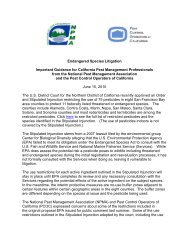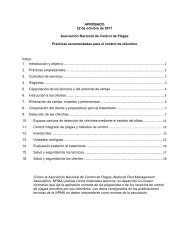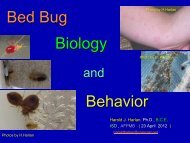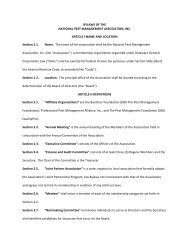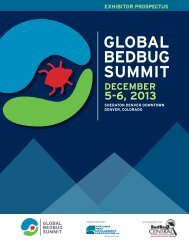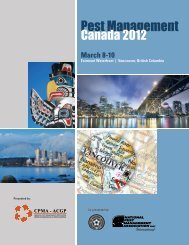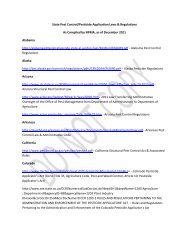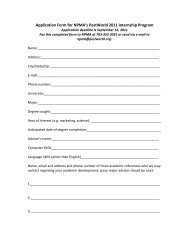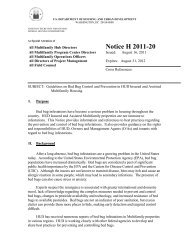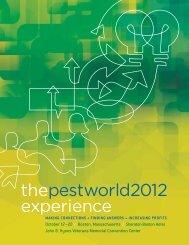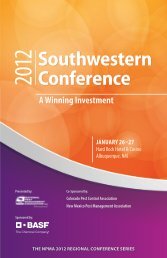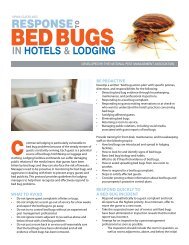Pest Management Standards For Food Plants - National Pest ...
Pest Management Standards For Food Plants - National Pest ...
Pest Management Standards For Food Plants - National Pest ...
You also want an ePaper? Increase the reach of your titles
YUMPU automatically turns print PDFs into web optimized ePapers that Google loves.
SECTION 2: PEST MANAGEMENT PLAN<br />
Non-regulated/exempt products (including but not limited to essential oil products,<br />
limestone dusts, etc.) may be used according to the instructions and in a crack and crevice<br />
or spot method only.<br />
Space treatment may be used to reduce adult populations. This may also include the use<br />
of insect growth regulators (IGRs).<br />
General applications may be used only if the use of the product will not contaminate the<br />
food product.<br />
<strong>Pest</strong>s may also be managed by fumigation after coordination with the plant contact.<br />
These standards do not address fumigation specifically.<br />
Insect bait stations may be used in areas not prone to heavy traffic or water accumulation.<br />
2<br />
SECTION<br />
Treatment of electrical panels and boxes must be done with extreme care per the label<br />
and liquids should not be used.<br />
Insect Light Traps and Flying Insect Traps<br />
Insect light traps (ILTs) may be installed to monitor and manage certain flying insects and<br />
to be used in the decision making process for adjusting the program for certain insects<br />
(e.g. Indianmeal moths, fruit flies, etc.). Findings and seasonal requirements will dictate<br />
frequency of inspection. Placement must be according to manufacturer’s instructions and<br />
in compliance with any regulatory policies and guidelines. In absence of instructions, ILTs<br />
should be placed where plant operations will not interfere with the operation. Typically,<br />
ILTs should be placed not less than two feet but not more than five feet above floor level<br />
unless specified by manufacturer instructions or due to special circumstances such as<br />
targeting high flying insects. Any ILT must be recorded on the site layout or map and ILTs<br />
must have the same recordkeeping as other types of traps.<br />
ILTs must be monitored based upon the contract and weekly monitoring is suggested for<br />
most cases unless the traps are in an area or at a time of year when there is no activity<br />
(e.g. unheated warehouse in winter in colder climates). The tray must be emptied. Insects<br />
in the tray must be examined and categorized according to:<br />
• stored product insects<br />
• flies<br />
• occasional invaders<br />
The technician should determine if the types and numbers of insects reveal a concern and<br />
if so, then the insect management program should be modified to address the issue.<br />
Bulbs in ILTs must be changed according to manufacturer’s recommendations but in any<br />
case at least annually. Shatter protection must be in place where food or packaging may<br />
become contaminated by glass.<br />
Sticky type ILTs must be monitored at least monthly and the sticky board must be replaced<br />
if ineffective. Type of insects on the board must be recorded and categorized according to<br />
above.<br />
Sticky type traps including pheromone sticky traps or other flying insect traps must be<br />
monitored at least monthly and the sticky material must be replaced at ineffective. Type<br />
of insects on the board must be recorded and categorized according to above.<br />
The insect program must be reviewed with the plant contact at least annually and<br />
adjustments must be made as necessary. Any services may not contaminate nor potentially<br />
contaminate food, food contact surfaces, or food packaging.<br />
13



